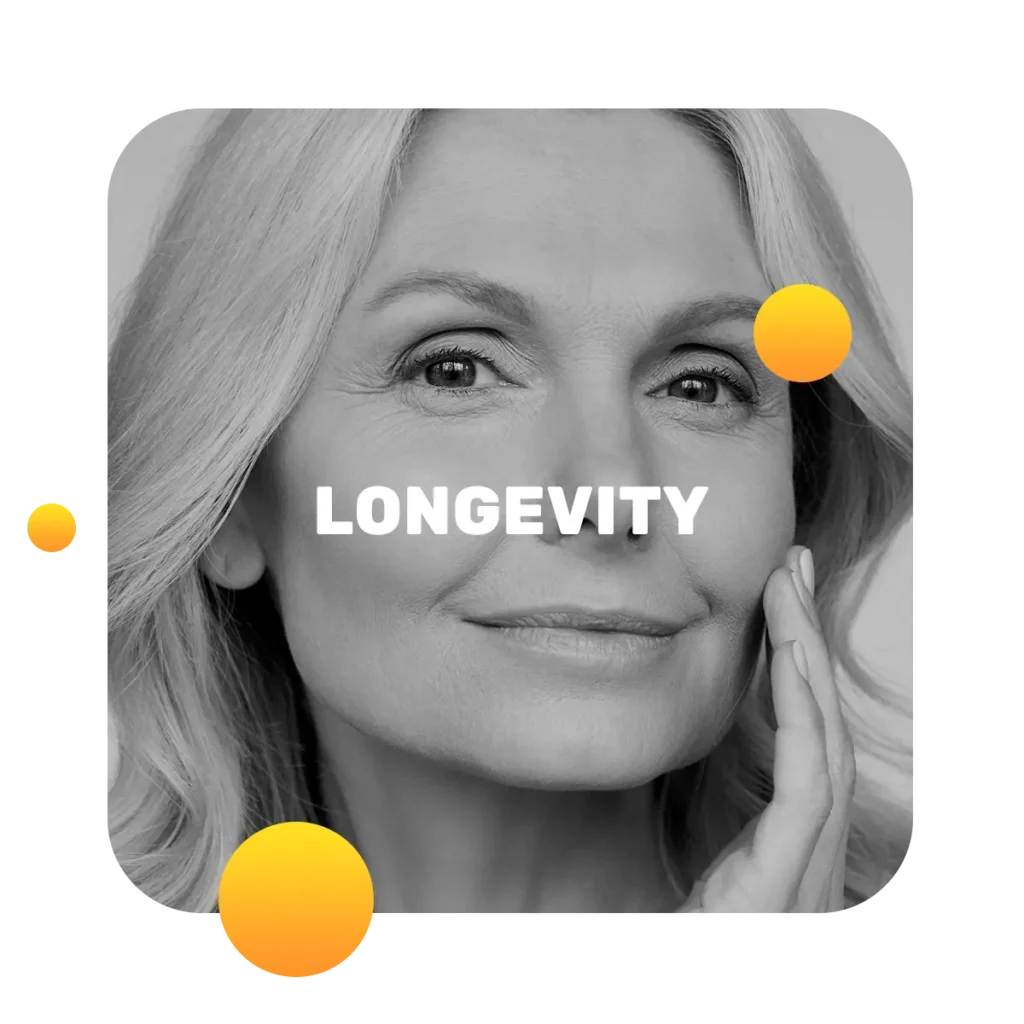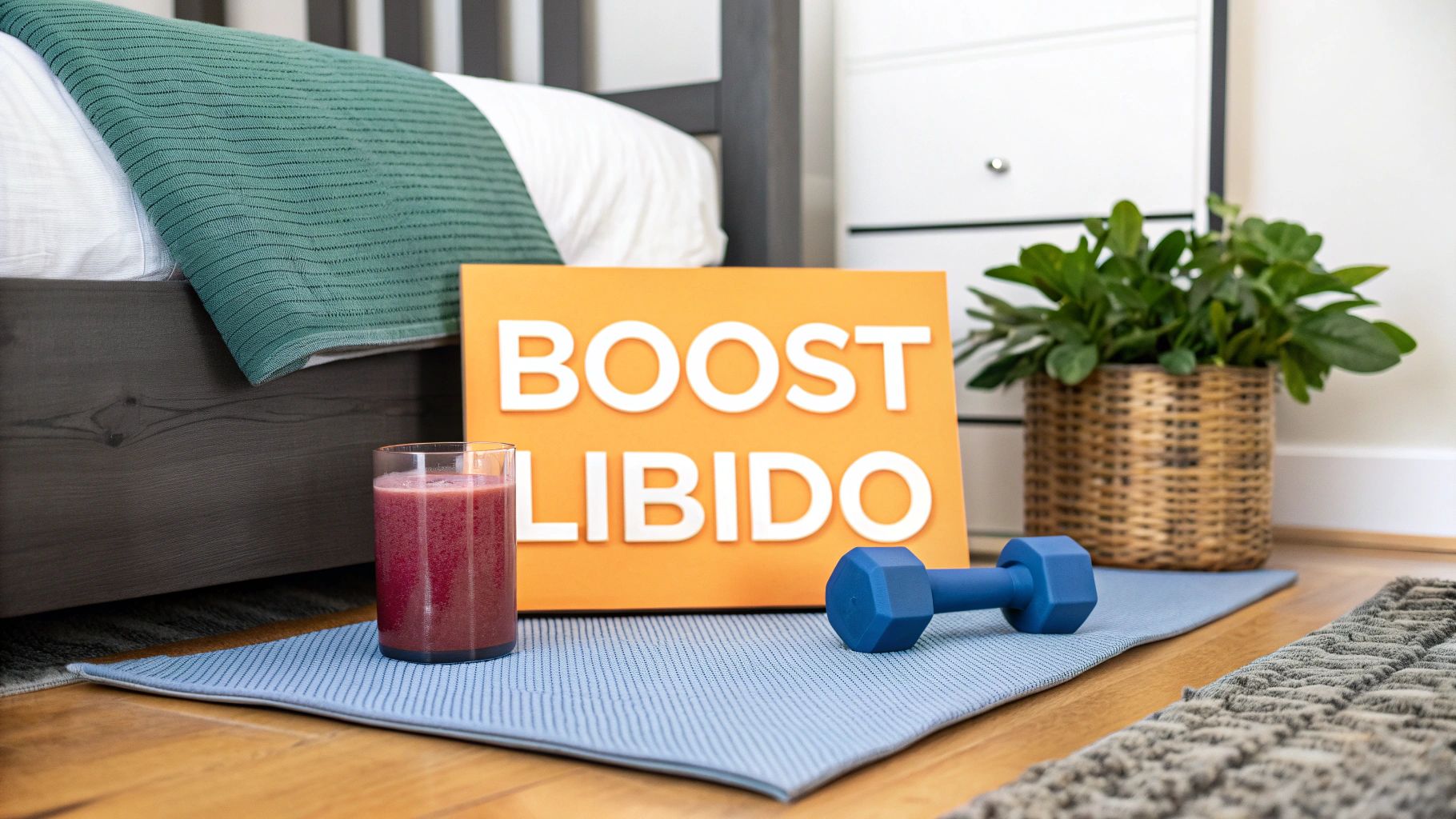The Guide to Exercise for Hormonal Balance

The right kind of exercise for hormonal balance isn't about crushing yourself at the gym; it's about making smart, targeted choices that support your body's endocrine system. It’s a strategic blend of strength training, mindful cardio, and restorative practices—all designed to work with your body, not against it.
How Movement Actually Influences Your Hormones
It’s easy to think of exercise with a simple formula: move more, feel better. But when your hormones are in the mix, the reality is far more complex. The type, intensity, and even the timing of your workout send very different signals to your body’s chemical messengers. This is the whole idea behind "hormone-supportive fitness."
A high-intensity interval training (HIIT) session, for example, can be amazing for improving insulin sensitivity. But if your body is already running on stress fumes, that same workout could trigger a massive spike in cortisol, your main stress hormone.
On the flip side, a restorative yoga class might not do much for your insulin levels, but it can work wonders for calming an overactive nervous system and bringing down those chronically high cortisol levels.
This visual map breaks down the direct connections between different types of exercise and key hormones like cortisol, estrogen, and insulin.
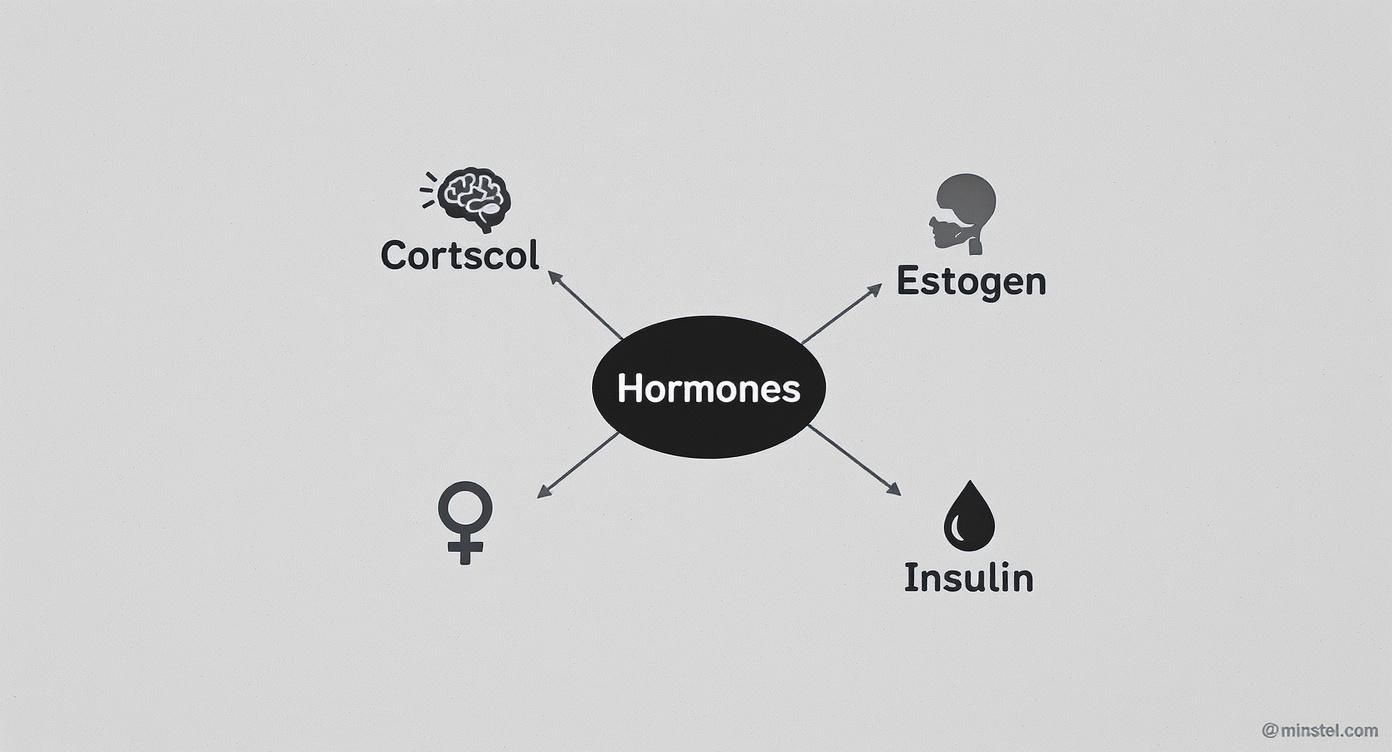
As you can see, each hormone has its own unique response to physical stress and movement signals.
To give you a clearer picture, let's look at how different workout styles can affect your hormones.
How Different Workouts Impact Your Key Hormones
This table gives you a quick look at how common exercise types affect major hormones, giving you a snapshot of what's happening inside your body when you move.
| Hormone | Impact of High-Intensity Training | Impact of Low-Intensity Movement | Main Benefit of Balance |
|---|---|---|---|
| Cortisol | Temporarily spikes to meet energy demand; can become chronically high if overdone. | Helps lower chronic levels and calm the nervous system. | Prevents burnout and adrenal fatigue. |
| Insulin | Improves insulin sensitivity, helping cells use glucose more efficiently. | Has a minimal but stable effect on blood sugar. | Maintains stable energy and prevents crashes. |
| Estrogen | Can help metabolize excess estrogen, but too much can disrupt ovulation. | Gentle movement supports healthy estrogen levels and detoxification. | Supports a regular menstrual cycle. |
| Testosterone | Boosts testosterone, which is key for muscle growth and libido. | Minimal impact, but supports overall hormonal harmony. | Builds lean muscle without over-stressing the body. |
Understanding these different hormonal responses is the first step in building a routine that works for you.
Finding Your Unique Balance
This is exactly why your friend’s intense workout routine might leave them feeling amazing while you feel completely drained. Your hormonal landscapes are different. Learning how specific movements impact your endocrine system is the key to building a routine that brings you into balance instead of pushing you further out of it.
Your body is constantly sending you signals. You just have to learn to listen.
Pay close attention to these key indicators:
- Energy Levels: Do you feel buzzed and ready to go after a workout, or are you totally wiped out for the rest of the day?
- Sleep Quality: Are you sleeping like a rock, or are you tossing and turning all night?
- Mood and Cravings: Have you noticed you're more irritable or battling intense sugar cravings after certain workouts?
By learning to interpret these signals, you can ditch the one-size-fits-all approach and start choosing exercises that truly serve your hormonal health. The goal isn't just to finish a workout; it's to create a positive hormonal response that lasts all day.
Using Strength Training to Support Your Metabolism
When most people think about strength training, the first thing that comes to mind is bigger muscles. But the most powerful benefits are happening on a much deeper level, directly influencing the hormones that dictate your metabolism, energy, and overall vitality. Lifting weights is a potent tool in your toolkit of exercise for hormonal balance, creating a positive ripple effect throughout your entire endocrine system.
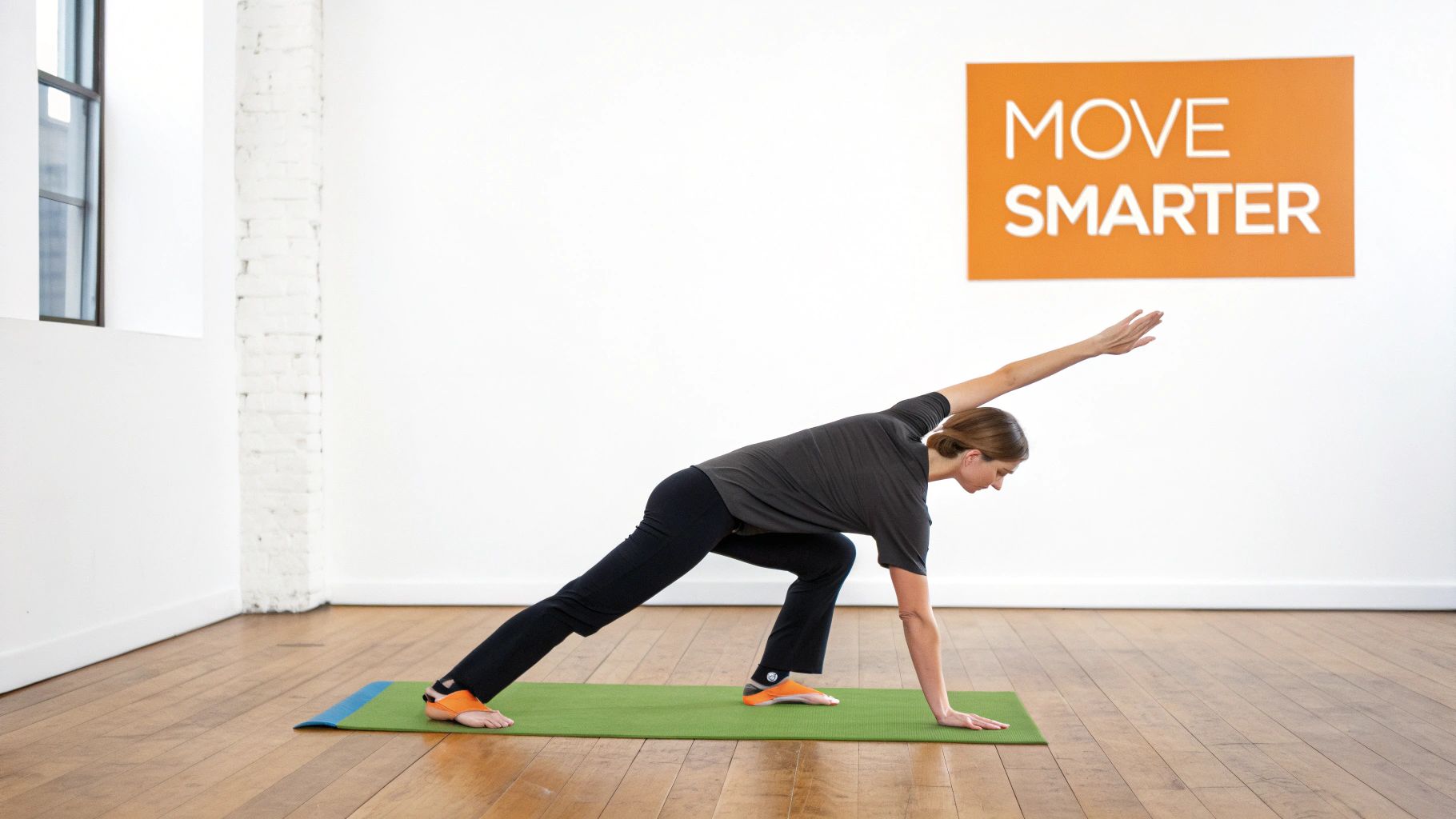
More than any other type of exercise, resistance training sends a clear signal to your body: build and maintain lean muscle. This is absolutely crucial because muscle tissue is metabolically active. Think of it like a sponge for glucose, helping to dial in your insulin sensitivity.
Every single time you contract your muscles against resistance, you’re training your cells to become more receptive to insulin. This means your body gets much better at managing blood sugar effectively. This improved insulin response is a true cornerstone of hormonal health, taking a huge strain off your pancreas and helping to prevent the metabolic chaos that leads to weight gain and fatigue.
Boosting Anabolic Hormones Naturally
Strength training also provides a powerful stimulus for your body to produce key anabolic hormones—the ones in charge of growth and repair. We’re talking about hormones like testosterone and human growth hormone (HGH).
These hormones have a natural tendency to decline as we get older, but a consistent lifting routine can help preserve or even boost their levels. Research has shown that exercise is a powerful modulator of hormonal balance, especially when it comes to testosterone. While a tough workout can give you a temporary spike in testosterone, consistent training leads to a healthier overall sex hormone profile in the long run.
This hormonal boost is essential for more than just building muscle. It translates to better energy, a stronger libido, an improved mood, and even greater bone density.
A Practical Weekly Strength Routine
You don’t have to live in the gym to unlock these benefits. A smart, focused approach built around compound movements—exercises that hit multiple muscle groups at once—is incredibly effective.
Here’s a simple but powerful plan you can do just two days a week:
-
Day 1: Lower Body & Push
- Goblet Squats: 3 sets of 8-12 reps
- Dumbbell Lunges: 3 sets of 10-12 reps per leg
- Dumbbell Bench Press: 3 sets of 8-12 reps
- Overhead Press: 3 sets of 8-12 reps
-
Day 2: Upper Body Pull & Hinge
- Dumbbell Rows: 3 sets of 8-12 reps per arm
- Lat Pulldowns (or Assisted Pull-ups): 3 sets to near failure
- Romanian Deadlifts: 3 sets of 10-12 reps
- Plank: 3 sets, holding for 30-60 seconds
The secret sauce here is progressive overload, which is just a fancy way of saying you need to make your workouts a little bit harder over time. This could mean lifting a slightly heavier weight, squeezing out one more rep, or shortening your rest periods. This continuous challenge is what keeps those positive hormonal adaptations coming. Building this foundation of strength is a key part of learning how to improve body composition for long-term health.
By building a stronger, more muscular frame, you are essentially creating a more resilient metabolic environment. Your body becomes better equipped to handle stress, manage blood sugar, and maintain a healthy hormonal equilibrium. It’s not just about aesthetics; it’s about building a foundation for lifelong wellness.
Smart Cardio for Managing Cortisol and Insulin
Cardio and hormones have a complicated relationship. Too much high-intensity work can leave you feeling wired and tired, while the right kind can be an absolute game-changer for managing stress and blood sugar.
The secret is knowing how different types of cardio send different signals to your body. Once you get that, you can pick the right tool for the job.
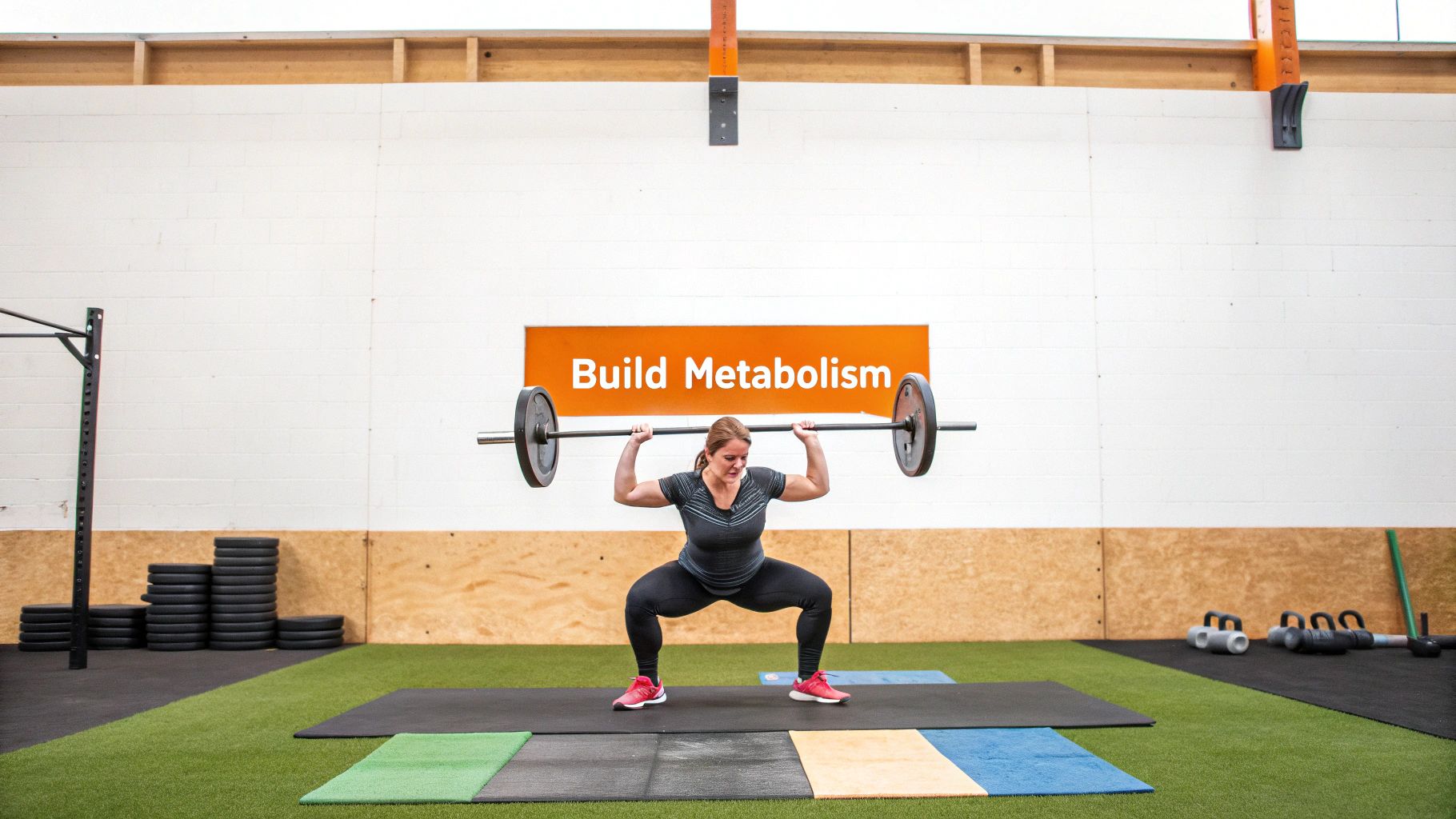
This is a core principle of using exercise for hormonal balance—matching your movement to what your body needs right now. We’re going to break down two powerful but very different approaches: fast, intense bursts to improve insulin sensitivity and slow, steady movement to lower cortisol.
Using HIIT to Improve Insulin Sensitivity
High-Intensity Interval Training (HIIT) is incredibly effective for improving how your body uses insulin. When you push yourself hard for short bursts, you create a massive demand for energy. This encourages your muscle cells to soak up glucose straight from your bloodstream, often without needing much insulin to do it.
This makes HIIT a fantastic tool for managing blood sugar and boosting your metabolic health. But because it’s so demanding, it also triggers a significant cortisol spike. That’s a normal, healthy response in the short term, but it’s also exactly why you can’t—and shouldn’t—do HIIT every day.
Here is a simple but effective 20-minute HIIT protocol to try:
- Warm-up: Get moving for 5 minutes with light cardio, like jogging in place or some dynamic stretches.
- Work Interval: Go all-out with an exercise like burpees, high knees, or kettlebell swings for 30 seconds.
- Rest Interval: Actively recover by walking or slowly marching in place for 60 seconds.
- Repeat: Keep this cycle going for a total of 10 rounds.
- Cool-down: Finish up with 5 minutes of gentle stretching.
This type of training is a classic case of "less is more." Just one or two sessions a week is often plenty to get the metabolic benefits without sending your stress hormones into overdrive.
Gentle Cardio for Cortisol Control
On the complete other end of the spectrum is low-intensity, steady-state cardio. Think of a long, brisk walk, a relaxed bike ride, or a gentle swim. This type of movement is a powerful antidote to chronic stress.
Instead of jacking up cortisol, it actually helps clear it from your system and soothes your nervous system. For a lot of people, this is the missing piece in their fitness routine.
The goal here is to stay in what’s often called "Zone 2," a heart rate where you could comfortably hold a conversation.
- Find Your Zone 2: A simple way to estimate this is 180 minus your age. This gives you a rough upper limit for your heart rate.
- Duration is Key: Aim for 30-60 minutes, 2-4 times per week. Consistency here matters way more than intensity.
This kind of gentle movement is perfect for active recovery days or any time you feel overwhelmed and stressed. It also helps you learn how to improve stamina naturally without burning yourself out.
Studies back this up. Regular aerobic exercise can have a profound impact on multiple hormones. One study found that a 16-week regimen of walking or jogging significantly lowered levels of free testosterone and DHEA-S. The most consistent improvements often come from combining this aerobic work with resistance training for a truly balanced approach. You can discover more insights about these findings on the National Library of Medicine's website.
Mindful Movement to Soothe Your Nervous System
While intense, heart-pumping exercise definitely has its place, the gentle, restorative side of movement is often the missing piece in a truly effective exercise for hormonal balance plan.
Practices like yoga, Pilates, and focused stretching are so much more than just a good stretch. They directly target your body’s central stress response system, known as the hypothalamic-pituitary-adrenal (HPA) axis.
When this system gets stuck in the “on” position from daily stressors, it floods your body with cortisol, keeping you in a constant state of high alert. Mindful movement is the antidote. It helps coax your body out of that frantic "fight-or-flight" mode and into the calm "rest-and-digest" state, which is absolutely essential for healthy hormone production and adrenal health.
Think of these calming practices as the perfect counterbalance to your more intense workouts. They make sure your fitness routine is building you up instead of just breaking you down.
Your 15-Minute Restorative Yoga Sequence
I’ve designed this simple sequence to help calm your nervous system, lower cortisol, and invite deep relaxation. You don’t need any special equipment—just a quiet space and a few minutes for yourself. Remember, the goal here isn't to get a workout, but to gently unwind both physical and mental tension.
The real magic happens when you focus on your breath. Deep, slow breathing sends a powerful signal to your brain that you are safe, helping to immediately dial down the stress response.
Here’s a simple routine to get you started:
1. Child’s Pose (Balasana)
Start on your hands and knees. From there, sit your hips back onto your heels and fold forward, letting your forehead rest on the floor. This pose gives your back and hips a gentle stretch while instantly calming the mind. Hold for 2 minutes.
2. Cat-Cow Stretch (Marjaryasana-Bitilasana)
Come back up to your hands and knees. As you inhale, drop your belly and look up toward the ceiling (Cow). As you exhale, round your spine and tuck your chin toward your chest (Cat). This simple spinal movement is fantastic for releasing tension and improving blood flow to your endocrine glands. Flow between the two for 2 minutes.
3. Legs-Up-the-Wall Pose (Viparita Karani)
This is one of my all-time favorites. Lie on your back and swing your legs up so they can rest against a wall. It's one of the most effective restorative poses out there, helping to reduce inflammation and improve circulation without putting any strain on your heart. Hold for 5 minutes.
This final pose is particularly powerful. By reversing the effects of gravity, you encourage lymphatic drainage and give your entire circulatory system a break. This can significantly lower the physical stress load on your body.
Why This Works for Hormonal Health
Each of these movements does more than just stretch your muscles. They are a form of active meditation that directly influences your body’s chemistry.
- Child's Pose applies gentle pressure to your forehead, which can stimulate the pituitary gland—a master controller of your entire endocrine system.
- Cat-Cow boosts circulation around the adrenal and reproductive organs, giving them the support they need to function optimally.
- Legs-Up-the-Wall is incredibly effective at activating the parasympathetic nervous system, which is your body's natural relaxation response.
Making time for a short, mindful session like this just a few times a week can have a profound impact. It teaches your body how to down-regulate after a stressful day or an intense workout, creating the resilience you need for long-term hormonal harmony.
How to Structure Your Week for Better Hormones
Knowing which exercises to do is one thing, but weaving them into a weekly plan you can actually stick with? That's where the real magic happens for your hormones.
A well-designed routine creates a powerful rhythm of stress and recovery that your endocrine system thrives on. The goal here isn’t some rigid, perfect program. It's about building a flexible template that empowers you to listen to what your body is telling you, day in and day out.
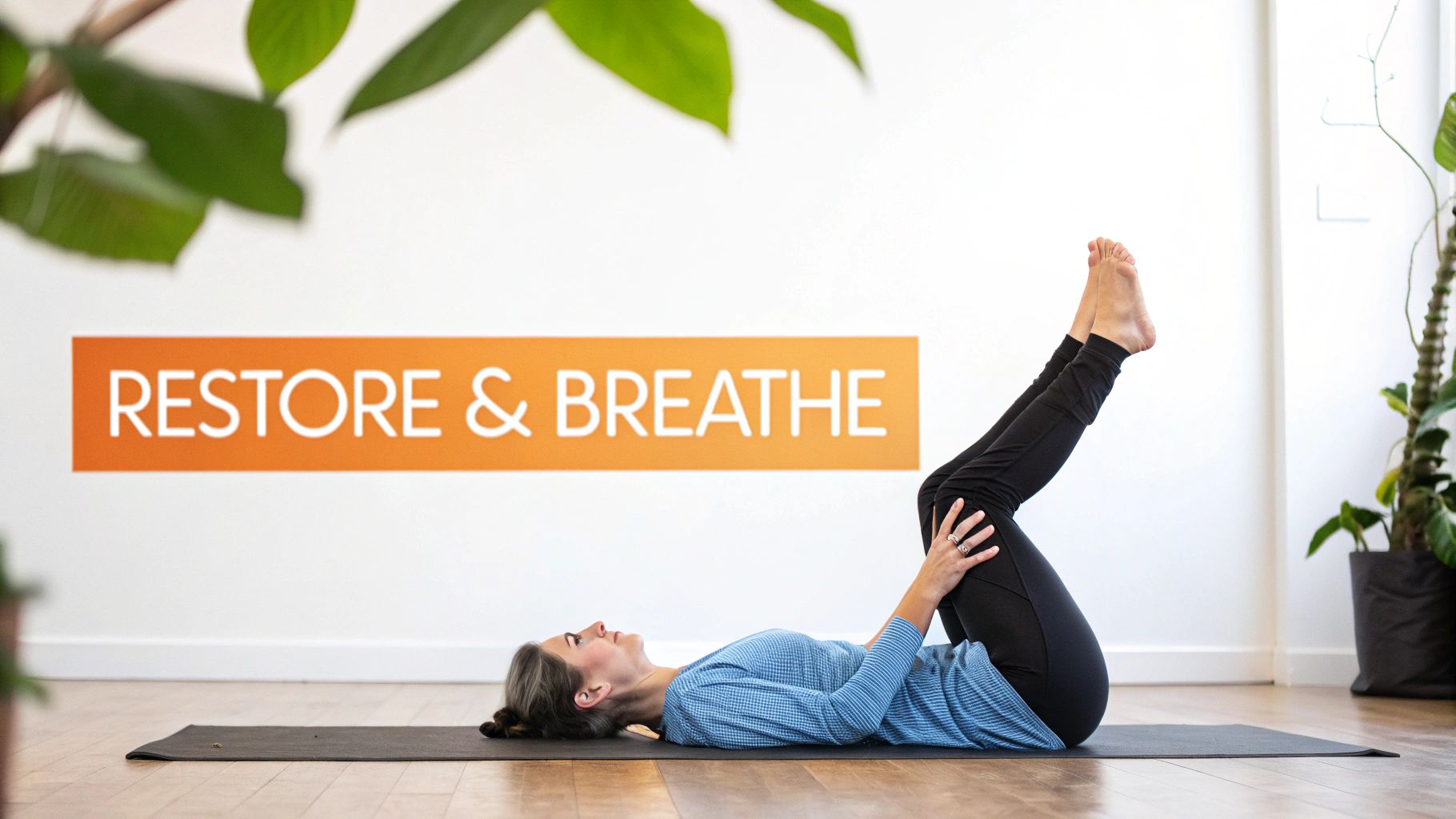
Think of it as thoughtfully balancing different types of movement throughout your week. This approach ensures you get the metabolic perks of intensity without flooding your system with too much cortisol. It’s a holistic plan where every workout complements the others.
A Sample Hormone-Supportive Weekly Schedule
Here’s a balanced template you can tweak to fit your own life and energy levels. It prioritizes strength, manages cortisol with gentle cardio, and carves out essential downtime for your nervous system to chill out.
- Monday: Strength Training (Lower Body & Push) – Kick off the week by stimulating muscle growth and boosting insulin sensitivity. Think big, compound movements like squats and presses.
- Tuesday: Zone 2 Cardio – A 45-minute brisk walk or a chill bike ride is perfect here. This helps clear out excess cortisol and promotes active recovery without adding more stress.
- Wednesday: Strength Training (Upper Body & Hinge) – Time to focus on movements like rows and Romanian deadlifts. Building a strong back and posterior chain is key.
- Thursday: Mindful Movement – Just 15-20 minutes of restorative yoga or deep stretching can do wonders to soothe your nervous system.
- Friday: Optional HIIT Session – If you're feeling energized and well-rested, a quick 20-minute HIIT workout can give you a fantastic metabolic boost. If not? Another walk is a great choice.
- Saturday: Active Recovery – Get moving in a way you genuinely enjoy. Go for a long, leisurely hike, play a sport with friends, or just have some fun.
- Sunday: Full Rest Day – This one is non-negotiable. Give your body a complete break to fully repair and rebuild.
This structure ensures you’re not just breaking your body down but also giving it plenty of time to heal—a cornerstone of learning https://elitebioscience.co/how-to-balance-hormones-naturally/.
Listening to Your Body’s Signals
Honestly, the most important part of any exercise plan for hormonal health is learning to adapt on the fly. Your body gives you constant feedback through signals like fatigue, cravings, poor sleep, and mood swings. Paying attention to them is everything.
If you wake up feeling wiped out on a scheduled strength day, forcing the workout is just counterproductive. Swapping it for a gentle walk or a yoga session isn't failure; it's smart, hormone-supportive training.
The relationship between your workouts and your hormones is a delicate dance. Training that's too intense or goes on for too long can create physiological stress that throws your hormones out of whack. On the other hand, moderate, regular exercise tends to be incredibly beneficial. Finding what works for your body is a process of trial and error.
Ultimately, the perfect plan is the one you can adapt without feeling guilty. Consistency over perfection is the mantra for long-term success. By blending different types of movement and honoring your body’s need for rest, you create a sustainable practice that builds resilience and fosters true hormonal harmony.
Common Questions on Exercise and Hormones
When you start using fitness to support your endocrine system, a few key questions always come up. Let's clear up some of the most common concerns about exercise and hormonal balance so you can move forward with confidence.
How Long Until I See Hormonal Changes
It's a classic question, and the answer is all about patience. You’ll probably feel an immediate mood and energy lift right after a good workout—that’s the endorphin rush. But true, lasting hormonal shifts are a different story. They don't happen overnight.
Generally, you can expect to notice tangible improvements in your sleep quality, daily energy levels, and overall mood within 4 to 6 weeks of consistent, smart training. That's the first sign you're on the right track. However, the deeper, more measurable changes in your hormonal markers—like better insulin sensitivity or a more stable cortisol rhythm—typically take 3 to 6 months of dedicated effort.
Remember, this is a long game. Lasting hormonal change is built on consistency and listening to your body, not on short-term intensity. Patience is your greatest asset here.
Can Exercise Actually Make My Hormones Worse
Absolutely. It’s one of the biggest misconceptions in fitness that more is always better. In reality, overtraining is one of the fastest ways to throw your hormones into chaos and push your body into a state of chronic stress.
When you consistently push yourself to the absolute limit without giving your body the recovery it needs, you’re asking for trouble. This can lead to a host of problems, including:
- Chronically elevated cortisol, leaving you feeling wired but exhausted.
- Suppressed reproductive hormones, which can mess with your menstrual cycle.
- A struggling thyroid, which can slow your metabolism to a crawl.
If you constantly feel drained, can't sleep well, notice you're more irritable, and your performance in the gym is actually declining, your body is sending you a clear signal: you're overdoing it. This is precisely why rest days and gentle, mindful movement are non-negotiable parts of any effective plan.
What Is the Single Best Exercise to Do
While there’s no single magic bullet—a balanced combination is always the most effective strategy—one type of exercise really stands out for its powerful hormonal benefits.
If you have to prioritize just one, make it compound strength training. Exercises like squats, deadlifts, overhead presses, and rows are incredibly efficient. They work multiple muscle groups at once, helping you build lean muscle mass, which is fantastic for improving insulin sensitivity and creating a healthier metabolic environment.
This type of training also supports healthy levels of testosterone and growth hormone, both of which are vital for energy, vitality, and body composition. When you pair consistent strength work with regular low-intensity movement like walking, you create an incredibly powerful foundation for lasting hormonal balance.
At Elite Bioscience, we provide advanced therapies to help you reach your health and performance goals. If you're looking to optimize your body's potential, explore our science-backed solutions. Discover more about our personalized hormone and peptide therapies at https://elitebioscience.co.
QUICK SEARCH
Make an account today to start your journey towards a better and healthier lifestyle.


